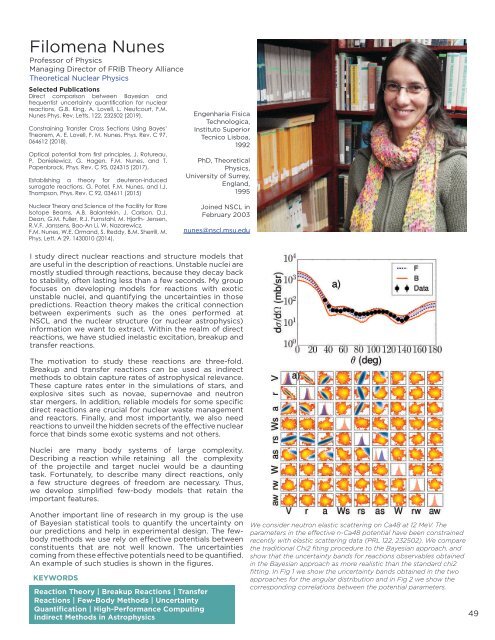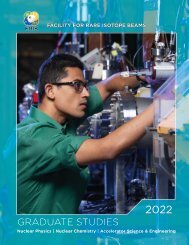2021FRIB/NSCL Graduate Brochure
You also want an ePaper? Increase the reach of your titles
YUMPU automatically turns print PDFs into web optimized ePapers that Google loves.
Filomena Nunes<br />
Professor of Physics<br />
Managing Director of FRIB Theory Alliance<br />
Theoretical Nuclear Physics<br />
Selected Publications<br />
Direct comparison between Bayesian and<br />
frequentist uncertainty quantification for nuclear<br />
reactions, G.B. King, A. Lovell, L. Neufcourt, F.M.<br />
Nunes Phys. Rev. Letts. 122, 232502 (2019).<br />
Constraining Transfer Cross Sections Using Bayes’<br />
Theorem, A. E. Lovell, F. M. Nunes. Phys. Rev. C 97,<br />
064612 (2018).<br />
Optical potential from first principles, J. Rotureau,<br />
P. Danielewicz, G. Hagen, F.M. Nunes, and T.<br />
Papenbrock, Phys. Rev. C 95, 024315 (2017).<br />
Establishing a theory for deuteron-induced<br />
surrogate reactions, G. Potel, F.M. Nunes, and I.J.<br />
Thompson, Phys. Rev. C 92, 034611 (2015)<br />
Engenharia Fisica<br />
Technologica,<br />
Instituto Superior<br />
Tecnico Lisboa,<br />
1992<br />
PhD, Theoretical<br />
Physics,<br />
University of Surrey,<br />
England,<br />
1995<br />
Nuclear Theory and Science of the Facility for Rare<br />
Isotope Beams, A.B. Balantekin, J. Carlson, D.J.<br />
Dean, G.M. Fuller, R.J. Furnstahl, M. Hjorth- Jensen,<br />
R.V.F. Janssens, Bao-An Li, W. Nazarewicz,<br />
F.M. Nunes, W.E. Ormand, S. Reddy, B.M. Sherrill, M.<br />
Phys. Lett. A 29, 1430010 (2014).<br />
Joined <strong>NSCL</strong> in<br />
February 2003<br />
nunes@nscl.msu.edu<br />
I study direct nuclear reactions and structure models that<br />
are useful in the description of reactions. Unstable nuclei are<br />
mostly studied through reactions, because they decay back<br />
to stability, often lasting less than a few seconds. My group<br />
focuses on developing models for reactions with exotic<br />
unstable nuclei, and quantifying the uncertainties in those<br />
predictions. Reaction theory makes the critical connection<br />
between experiments such as the ones performed at<br />
<strong>NSCL</strong> and the nuclear structure (or nuclear astrophysics)<br />
information we want to extract. Within the realm of direct<br />
reactions, we have studied inelastic excitation, breakup and<br />
transfer reactions.<br />
The motivation to study these reactions are three-fold.<br />
Breakup and transfer reactions can be used as indirect<br />
methods to obtain capture rates of astrophysical relevance.<br />
These capture rates enter in the simulations of stars, and<br />
explosive sites such as novae, supernovae and neutron<br />
star mergers. In addition, reliable models for some specific<br />
direct reactions are crucial for nuclear waste management<br />
and reactors. Finally, and most importantly, we also need<br />
reactions to unveil the hidden secrets of the effective nuclear<br />
force that binds some exotic systems and not others.<br />
Nuclei are many body systems of large complexity.<br />
Describing a reaction while retaining all the complexity<br />
of the projectile and target nuclei would be a daunting<br />
task. Fortunately, to describe many direct reactions, only<br />
a few structure degrees of freedom are necessary. Thus,<br />
we develop simplified few-body models that retain the<br />
important features.<br />
Another important line of research in my group is the use<br />
of Bayesian statistical tools to quantify the uncertainty on<br />
our predictions and help in experimental design. The fewbody<br />
methods we use rely on effective potentials between<br />
constituents that are not well known. The uncertainties<br />
coming from these effective potentials need to be quantified.<br />
An example of such studies is shown in the figures.<br />
KEYWORDS<br />
Reaction Theory | Breakup Reactions | Transfer<br />
Reactions | Few-Body Methods | Uncertainty<br />
Quantification | High-Performance Computing<br />
Indirect Methods in Astrophysics<br />
We consider neutron elastic scattering on Ca48 at 12 MeV. The<br />
parameters in the effective n-Ca48 potential have been constrained<br />
recently with elastic scattering data (PRL 122, 232502). We compare<br />
the traditional Chi2 fiting procedure to the Bayesian approach, and<br />
show that the uncertainty bands for reactions observables obtained<br />
in the Bayesian approach as more realistic than the standard chi2<br />
fitting. In Fig 1 we show the uncertainty bands obtained in the two<br />
approaches for the angular distribution and in Fig 2 we show the<br />
corresponding correlations between the potential parameters.<br />
49






